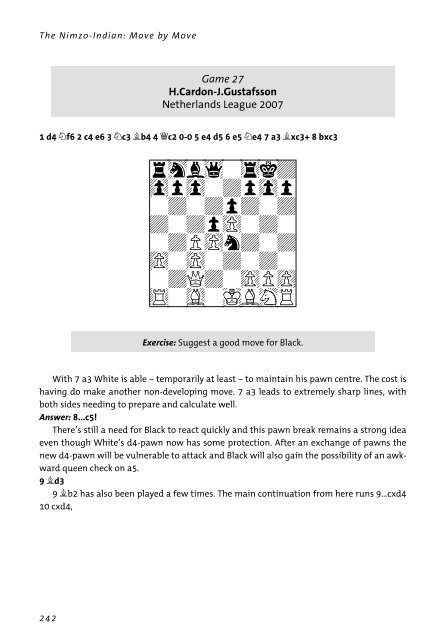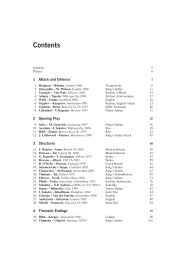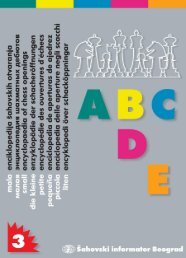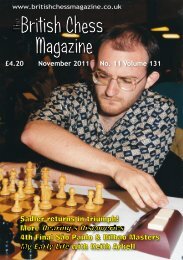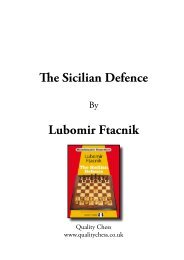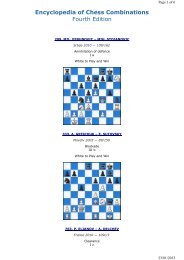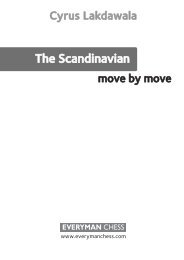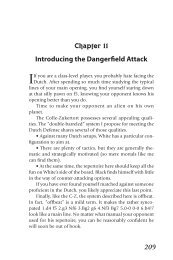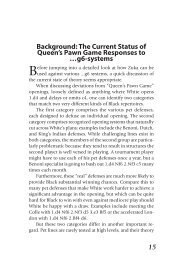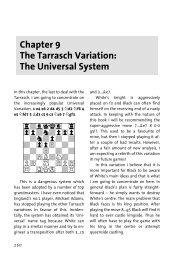View sample pages (pdf) - Chess Direct Ltd
View sample pages (pdf) - Chess Direct Ltd
View sample pages (pdf) - Chess Direct Ltd
Create successful ePaper yourself
Turn your PDF publications into a flip-book with our unique Google optimized e-Paper software.
The Nimzo-Indian: Move by MoveAnswer: Black plays 13...f5!. Other moves are possible (e.g. 13 ...Ía4) but the point to note isthat ...f5 is often a good answer to f3 when White’s bishop is on d3, because if White takesthe knight Black regains the piece by recapturing and trapping the bishop. Instead Whitehas played 14 exf6 Ìxf6 but this position is fine for Black.I’ve faced the move 11 Ìe2!? (instead of 11 Íd3), intending to block the check on a5 withÌc3, against Andrew Whiteley in a London League match. The game continued 11...Ìc6 12Îd1! f6!? (I couldn’t work out all the variations, but 12...f6 just felt right) 13 Ìc3 Ëa5 14 f3fxe5!? 15 cxd5! (against 15 dxe5 Black can play 15...Ìc5! intending 16 cxd5 Ìxe5) 15...exd416 fxe4! (after 16 dxc6 dxc3 17 Ía1 Íxc6 18 fxe4 there’s the very strong 18...Ëb6! combiningideas of ... Ía4 and ...Ëe3+) 16...exd5! 17 exd5? (during the game 17 Ëb3! was the move Ithought was best, and indeed this is the case: 17...dxc3 18 Íxc3 Ëb6 19 Ëxb6 axb6 20 Îxd5Íe6 21 Îg5 g6 looks roughly equal) 17...Îae8+ 18 Íe2 (A.Whiteley-J.Emms, London League2008) and here the computer shows me the win I annoyingly missed: 18...Îxe2+! 19 Êxe2Íg4+ 20 Êe1 Îe8+! 21 Êf2 Ëc5! (the crucial move – I didn’t see this idea) 22 Êg3 (22 dxc6d3+!) 22...Îe3+ 23 Êxg4 Ìe5+ 24 Êf4 g5+ and it’s mate in a few moves.Let’s return to Cardon’s choice, the less risky 9 Íd3 – relative speaking of course!W________W[rhb1W4kD][0pDWDp0p][WDWDpDWD][DW0p)WDW][WDP)nDWD][)W)BDWDW][WDQDW)P)][$WGWIWHR]W--------W9...cxd4!Black’s route to counterplay involves an early ...Ëa5. The only issue is whether or not hechooses to exchange on d4 first. Both are entirely playable.The main line after 9...Ëa5! runs 10 Ìe2 (if 10 Íxe4 dxe4 11 Íd2 then 11...Ëa6! beginsto exploit White’s missing light-squared bishop) 10...cxd4 (the only consistent continuation)11 cxd5! (old theory had run 11 0-0 dxc3 12 Íe3 Ìc6 13 cxd5 exd5 14 f3 Ìd2 15Íxh7+ Êh8 16 Íxd2 cxd2 with a clear plus for Black, N.Kelecevic-B.Abramovic, Yugoslavia1984; 11 cxd5 brought the variation back to life) 11...exd5 12 f3 Ìxc3! 13 Ìxd4 (13 Íxh7+is better for Black after 13...Êh8 14 Ìxd4 Ìe4+! 15 Êf1 Êxh7 16 fxe4 Êg8 or 14 Íd3 Ìc615 0-0 Ìxe5 16 Ìxd4 Íd7; while 13 0-0!? is an interesting gambit, albeit probably notquite sound after 13...Ìc6 14 f4 Ëa4) 13...Ìe4+! 14 Êe2.In this position we can use our knowledge from the previous exercise to help us with244
Classical Variation: 4 Ëc2 0-0Black’s best move: 14...f5!.W________W[rhbDW4kD][0pDWDW0p][WDWDWDWD][1WDp)pDW][WDWHnDWD][)WDBDPDW][WDQDKDP)][$WGWDWDR]W--------WI first became aware of this strong move when Chris Ward showed it to me (he andTimothy Woodward had found it while analysing this variation). After that there was ahigh-profile encounter with 14...f5 and the theory was supplemented by some publishedanalysis by Kasparov and Leko. They concluded that best play led to a draw, and nothingsince has altered this assessment. Here’s a summary of what Black really needs to know:a) 15 fxe4? fxe4 16 Íb5 Íg4+ 17 Êe3 Ëd8! (threatening ...Ëg5 mate) 18 h4 Ëb6! (nowit’s ...Ëh6) 19 e6 Ëd6! (and now, with the h-pawn moved, it’s ...Ëg3!) 20 Ìe2 d4+. Here 21Êd2 d3 is terminal while 21 Ìxd4 allows mate in one with 21...Ëf4.b) 15 Íe3 Ìc6! 16 Ìxc6 bxc6 17 Îhc1 Îb8 18 Êf1 (18 Êd1 Îd8 was good for Black inF.Vallejo Pons-P.Leko, Morelia/Linares 2006) 18...f4! 19 Íxe4 fxe3 20 Íxh7+ Êh8 21 Íd3with an edge for Black according to Leko.c) 15 e6! is best, preventing ...Íd7 and introducing tactics involving e6-e7: 15...Ìc6! 16Ìxc6 bxc6 17 e7 Îe8 18 Ëxc6W________W[rDbDrDkD][0WDW)W0p][WDQDWDWD][1WDpDpDW][WDWDnDWD][)WDBDPDW][WDWDKDP)][$WGWDWDR]W--------W245
The Nimzo-Indian: Move by Move18...Îxe7! (18...Íb7 doesn’t quite work: 19 Ëxb7 Îab8 20 Ëc6 Îb2+ 21 Êe3! d4+ 22Êxd4 Îxe7 23 Ëd5+! Ëxd5+ 24 Êxd5 Ìf6+ 25 Êc4 Îc7+ 26 Êd4 – Kasparov – and Whiteescapes with his extra material) 19 Ëxa8 Ìg3+! 20 Êd1 Ëc3 21 Íd2 Ëxa1+ 22 Íc1 Ëc3! (Iprefer White after 22...Ìxh1 23 Ëxc8+ Êf7 24 Ëxf5+ Ëf6 25 Ëxd5+) 23 Íd2 Ëa1+ 24 Íc1(Kasparov/Leko) when neither side can avoid a repetition of moves.After those crazy tactics, let’s return to the game and Gustafsson’s choice of 9...cxd4:10 cxd4 Ëa5+!W________W[rhbDW4kD][0pDWDp0p][WDWDpDWD][1WDp)WDW][WDP)nDWD][)WDBDWDW][WDQDW)P)][$WGWIWHR]W--------WBlack mustn’t delay his counterplay – he can’t get by on just “development”. The positionafter 10...Ìc6 11 Ìe2 Íd7? (11...Ëa5+!) 12 0-0 shows just how easy it is for Black towind up in a terrible position if he doesn’t play with enough energy. The threats of f2-f3 orsimply Íxe4 are not easy to meet here.11 Êf1!Clearly White must be prepared to lose castling rights if he wants to play this line!11 Íd2 isn’t a bad move, but attack-minded players won’t play 5 e4 just to reach aqueenless middlegame arising after 11...Ìxd2 12 Ëxd2 Ëxd2+ 13 Êxd2. Furthermore,Black’s position is very comfortable after 13...dxc4! 14 Íxc4 Ìc6 followed by ...Îd8, ...b6,...Íb7 and ...Ìe7 or ...Ìa5 etc.11 Êe2 intends to castle by hand with Ìf3, Îe1 and Êf1, but with 11...Íd7! 12 Ìf3Ía4! Black gets excellent play. For example, 13 Ëb2 Ìc3+! 14 Êf1 dxc4 15 Íxc4 Îc8! andBlack has built up a quick-fire initiative. Now the greedy 16 Ëxb7? is punished beautifullyby 16...Îxc4! 17 Ëxa8 Ëa6! 18 Êg1 Ìe2+ 19 Êf1 Îxc1+ 20 Îxc1 Ìg3+ 21 Êg1 Ëf1+! 22Îxf1 Ìe2 mate, but even before 16 Ëxb7 White was struggling.11...Ìc6Hitting d4. Black can play this move because if White takes twice on e4, 13...Ëc3 will regainthe pawn with a clear advantage.12 Ìe2246
W________W[rDbDW4kD][0pDWDp0p][WDnDpDWD][1WDp)WDW][WDP)nDWD][)WDBDWDW][WDQDN)P)][$WGWDKDR]W--------WClassical Variation: 4 Ëc2 0-0Exercise: Try to work out what’s going on after 12...Ìb4.In Dangerous Weapons: The Nimzo-Indian I suggested the speculative pawn sacrifice 12Íb2!? Ìd2+ 13 Êe2 but there has been no takers so far. I gave 13...Ìxc4 14 Íc3! (14Íxh7+ Êh8 15 Íd3 Ëb6! 16 Íxc4 Ìxd4+! is good for Black) 14...Ëb6 15 Ìf3! h6 16 Îhc1!Íd7 17 Êf1 Îac8 18 Êg1. Black is solid enough with a strong knight on c4, but White doeshave some compensation in view of the plan Ëe2, Íb1 and Ëd3.12...f6!Logically trying to open the f-file in order to get at White’s uncastled king.Answer: 12...Ìb4!? to get rid of White’s light-squared bishop is clearly a tempting idea, and13 Ëb1 Ìxd3 14 Ëxd3 f6! would leave Black with a considerable advantage. However, inthis line it appears that we should always expect the unexpected. The exchange sacrificewith 13 axb4! Ëxa1 is much stronger, especially as after 14 f3 Black faces the usual problemof a trapped knight.W________W[rDbDW4kD][0pDWDp0p][WDWDpDWD][DWDp)WDW][W)P)nDWD][DWDBDPDW][WDQDNDP)][1WGWDKDR]W--------W247
The Nimzo-Indian: Move by MoveAgain the solution is 14...f5! (14...Ìg5? loses to 15 h4) and here theory runs 15 Ëb1Ëa4! 16 Êe1! (preventing the mate threat on d1 and preparing fxe4) 16...a5! 17 fxe4 fxe418 Íc2 Ëxb4+ 19 Ëxb4 axb4. This imbalanced endgame position was reached inV.Ivanchuk-D.Navara, Antalya 2004, which continued 20 cxd5 exd5 21 Íb3 Íe6 22 Îf1Îxf1+ 23 Êxf1 and the game was eventually drawn, although here all three results remainpossible.Let’s return to the game and the position after Gustafsson’s 12...f6:13 Íxe4After 13 exf6 Ìxf6! Black has solved the problem of his knight, while White still has tofind a good home for his king. This was demonstrated in G.Pataki-P.Horvath, Budapest2004: 14 Íe3 Íd7 15 Ëd2?! when 15...Ìg4! 16 f3 e5! would have left White in a dire situation.In H.Bellmann-J.Alvarez Sabor, correspondence 2007, White improved considerablywith 14 Îb1! dxc4 15 Ëxc4 Êh8 16 f3 Ëd8 17 Íg5 e5 18 d5 Ìe7 19 Íxf6 Îxf6 20 Êf2Ìxd5 21 Îhd1 Îd6 22 Íc2 Íe6 23 Ëe4 Íg8 24 Ëxe5 Îe6 25 Ëd4 Îxe2+ 26 Êxe2 Ëc7 27Íe4 Ìc3+ and here a draw was agreed.13...dxe4 14 exf6 Ëf5!W________W[rDbDW4kD][0pDWDW0p][WDnDp)WD][DWDWDqDW][WDP)pDWD][)WDWDWDW][WDQDN)P)][$WGWDKDR]W--------WThere’s nothing really wrong with the obvious recapture 14...Îxf6, but Gustafsson’schoice may be stronger. Black’s pieces become better coordinated: the queen is well placedon f6 while the rook is less vulnerable on f8.15 Íe3 Ëxf6Finally the position has settled and the stage is set for an intriguing struggle. White’splan is to sort out his king (normally with h2-h3 followed by Êg1-h2, but h2-h4 and Îh3 isanother, more aggressive possibility) before exploiting Black’s pawn weaknesses. Meanwhile,Black will engineer counterplay with either ...e6-e5 or ...b7-b6 and ...Ía6 laying siegeon White’s c4-pawn.Or White could just take the pawn:16 Ëxe4248
W________W[rDbDW4kD][0pDWDW0p][WDnDp1WD][DWDWDWDW][WDP)QDWD][)WDWGWDW][WDWDN)P)][$WDWDKDR]W--------WExercise: Find a good reply for Black.Classical Variation: 4 Ëc2 0-0Let’s take a look at a couple of alternatives where White aims to consolidate before capturing:a) 16 Îd1 is well met by 16...b6!, planning either ...Íb7 or ...Ía6 to hit c4. T.Woodward-P.Wells, British League 2005, continued 17 Êg1 (or 17 Ëxe4 Íb7 with good compensation)17...Ía6! 18 h4! Ìa5 19 Ëxe4 Ìxc4 20 Ìf4 Îae8 21 Îh3 Ìxe3 and a draw was agreed. It’spossible Black could play on here with 22 fxe3 e5, though White should be okay after 23Ëd5+ Êh8 24 dxe5 Îxe5 25 Ëd6.b) In Dangerous Weapons: The Nimzo-Indian I suggested 16 h3!? to play Êg1-h2 asquickly as possible. Amongst other lines, I gave 16...e5 17 d5 Ìd4 18 Ëc3 Ìf5 19 Êg1 b6 20Ìg3! Ìxg3 21 fxg3 Ía6 22 c5 followed by Êh2 with an unclear position. I don’t have muchto add to that, except to say that 16...b6 looks reasonable here too, and that either 16 Îd1or 16 h3 looks better than Cardon’s choice in the game.Answer: 16...e5!This was the move 16 Îd1 was designed to prevent (16 Îd1 e5 17 d5!). In this position,though, 16...e5 allows Black to fully mobilize his army and also force open the position – 17d5?? loses instantly to the tactic 17...Íf5! 18 Ëf3 e4!. In view of this, Black has more thanenough play for the pawn.17 dxe5 Ìxe5! 18 Íd4 Ìxc4!Another tactic. It’s very possible that Gustafsson didn’t have to work this out over theboard, since both 16...e5 and 18...Ìxc4 had been previously pointed out (by Golod).249
The Nimzo-Indian: Move by MoveW________W[rDbDW4kD][0pDWDW0p][WDWDW1WD][DWDWDWDW][WDnGQDWD][)WDWDWDW][WDWDN)P)][$WDWDKDR]W--------W19 Íxf6 Ìd2+ 20 Êg1 Ìxe4 21 Íd4 b6Black’s greater piece activity certainly counts for something in this ending, although Isuspect with accurate defence the odds are still in favour of a draw and this is the final resultof the game. The remaining moves were:22 Ìg3 Îd8 23 Íe3 Ìc3 24 h3 Ìd1 25 Íc1 Ía6 26 f3 Îac8 27 Ìe4 Íb7 28 Íg5 Îd5 29Íf4 Ìc3 30 Ìxc3 Îxc3 31 Êh2 g5 32 Îhc1 Îxc1 33 Íxc1 Îd1 34 Êg3 Êf7 35 h4 gxh4+ 36Êxh4 Êe6 37 Êg3 Êd5 38 Íb2 Îxa1 39 Íxa1 a5 40 Íf6 b5 41 Íc3 b4 42 axb4 axb4 43Íxb4 Êe6 44 Êf4 Êf7 45 Êg5 Íd5 46 Íc3 Ía2 47 f4 Íb3 48 g4 Íd1 49 f5 Êg8 50 Êf4Êf7 51 g5 Íc2 52 Êe5 Íb1 53 Íb4 ½-½Key Notes1. A principle Black should remember in the 4...0-0 5 a3 Íxc3+ 6 Ëxc3 d5 line is “initiativeat all costs”. This attitude forms the basis of Black’s choices in many of the games ofthis chapter.2. After 4...0-0 5 a3 Íxc3+ 6 Ëxc3 d5 White has the two bishops, Black a lead in development.In an open position, a lead in development often trumps the advantage of the twobishops. For this reason Black aims to open up the position as quickly as possible, for exampleafter 7 Ìf3 dxc4!, 7 Íg5 c5! or 7 Íg5 dxc4! (see Games 21-24).3. Black should definitely be prepared to offer pawn sacrifices in return for activity insome lines (see Games 21-23).4. White can avoid complications by playing 7 e3 but only at a cost of blocking in hisdark-squared bishop. In this case Black should just accept this concession by White ratherthan trying to blow 7 e3 off the board (see Game 25).5. The 5 e4 line (Games 26-27) is extremely sharp and has become quite theoretical inthe past 10 years. There are no shortcuts for either player here – you need to do yourhomework to play this line successfully.250


